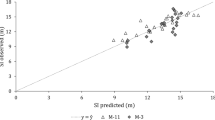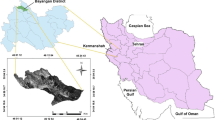Abstract
A geographic information system (GIS) approach was used in conjunction with forest-plot data to develop an integrated moisture index (IMI), which was then used to predict forest productivity (site index) and species composition for forests in Ohio. In this region, typical of eastern hardwoods across the Midwest and southern Appalachians, topographic aspect and position (rather than elevation) change drastically at the fine scale and strongly influence many ecological functions. Elevational contours, soil series mapping units, and plot locations were digitized for the Vinton Furnace Experimental Forest in southeastern Ohio and gridded to 7.5-m cells for GIS modeling. Several landscape features (a slope-aspect shading index, cumulative flow of water downslope, curvature of the landscape, and water-holding capacity of the soil) were used to create the IMI, which was then statistically analyzed with site-index values and composition data for plots. On the basis of IMI values for forest land harvested in the past 30 years, we estimated oak site index and the percentage composition of two major species groups in the region: oak (Quercus spp.), and yellow poplar (Liriodendron tulipifera) plus black cherry (Prunus serotina). The derived statistical relationships were then applied in the GIS to create maps of site index and composition, and verified with independent data. The maps show the oaks will dominate on dry, ridge top positions (i.e., low site index), while the yellow poplar and black cherry will predominate on mesic sites. Digital elevation models with coarser resolution (1:24K, 1:100K, 1:250K) also were tested in the same manner. We had generally good success for 1:24K, moderate success for 1:100K, but no success for 1:250K data. This simple and portable approach has the advantage of using readily available GIS information which is time-invariant and requires no fieldwork. The IMI can be used to better manage forest resources where moisture is limiting and to predict how the resource will change under various forms of ecosystem management.
Similar content being viewed by others
References
Abrams, M.D. and Nowacki, G.J. 1992. Historical variation in fire, oak recruitment, and post-logging accelerated succession in central Pennsylvania. Bulletin of the Torrey Botanical Club 119: 19–28.
Allen, R.B. and Peet, R.K. 1990. Gradient analysis of forests of the Sangre de Cristo Range, Colorado. Canadian Journal of Botany 68: 193–201.
Band, L.E. and Wood, E.F. 1988. Strategies for large-scale distributed hydrologic simulation. Applied Mathematics and Computation 27: 23–27.
Beatley, J.C. and Bartley, F. 1959. The primeval forests of a periglacial area in the Allegheny Plateau. Bulletin of the Ohio Biological Survey 1: 25–166.
Beck, D.E. 1990. Liriodendron tulipiferaL. Yellow poplar. In Silvics of North America: 2. Hardwoods. pp. 406–416. Edited by R.M. Burns and B.H. Honkala (tech. coords.) U.S. Department of Agriculture, Agriculture Handbook 654, Washington, DC. 877 pp.
Berguson, W.E., Grigal, D.F. and Bates, P.C. 1994. Relative stocking index: a proposed index of site quality. Canadian Journal of Forest Research 24: 1330–1336.
Beven, K.J. 1986. Runoff production and flood frequency in catchments of order n: an alternative approach. InScale Problems in Hydrology. pp. 107–131. Edited by V.K. Gupta, I. Rodriguez-Iturbe and E.F. Woods. D. Reidel Publishing Co., Dordrecht.
Bowersox, T.W. and Ward, W.W. 1972. Prediction of advance regeneration in mixed-oak stands of Pennsylvania. Forest Science 18: 278–282.
Carmean, W.H. 1965. Black oak site quality in relation to soil and topography in southeastern Ohio. Soil Science Society of America Proceedings 29: 308–312.
Crow, T.R. 1988. Reproductive mode and mechanisms for self-replacement of northern red oak (Quercus rubra) — a review. Forest Science 34: 19–40.
Dennis, D.F. and Birch, T.W. 1981. Forest statistics for Ohio-1979. U.S. Department of Agriculture, Forest Service, Resource Bulletin NE-68. 79 pp.
Dubrule, O. 1984. Comparing splines and kriging. Computers and Geosciences 10: 327–338.
Environmental Systems Research Institute. 1994. ArcDoc. (On-line documentation for Arc/Info software). Environmental Systems Research Institute, Redlands, CA.
Fox, L., Brockhus, J.A. and Tosta, N.D. 1985. Classification of timberland productivity in northwestern California using Landsat, topographic, and ecological data. Photogrammetric Engineering and Remote Sensing 51: 1745–1752.
Frank, T.D. and Thorn, C.E. 1985. Stratifying alpine tundra for geomorphic studies using digitized aerial imagery. Arctic and Alpine Research 17: 179–188.
Fralish, J.S. 1994. The effect of site environment on forest productivity in the Illinois Shawnee Hills. Ecological Applications 4: 134–143.
Franklin, J. 1995. Predictive vegetation mapping: geographic modelling of biospatial patterns in relation to environmental gradients. Progress in Physical Geography 19: 494–519.
Frothingham, E.H. 1921. Height growth as a key to site. Journal of Forestry 16: 754–760.
Garten, C.T., Huston, M.A. and Thoms, C.A. 1994. Topographic variation of soil nitrogen dynamics at Walker Branch watershed, Tennessee. Forest Science 40: 497–512.
Golet, F.C., Calhoun, A.J.K., DeRagon, W.R., Lowry, D.J. and Gold, A.J. 1993. Ecology of red maple swamps in the glaciated northeast: a community profile. U.S. Department of Interior, Fish and Wildlife Service, Biological Report 12, Washington, DC. 151 pp.
Good, N.F. and Good, R.E. 1972. Population dynamics of tree seedlings and saplings in a mature eastern hardwood forest. Bulletin of the Torrey Botanical Club 99: 172–178.
Griffith, D.M., DiGiovanni, D.M., Witzel, T.L. and Wharton, E.H. 1993. Forest statistics for Ohio, 1991. U.S. Department of Agriculture, Forest Service, Resource Bulletin NE-128. 169 pp.
Hepting, G.H. 1971. Diseases of forest and shade trees of the United States. U.S. Department of Agriculture, Agricultural Handbook 386, Washington, DC. 658 pp.
Heiligmann, R.B., Norland, E.R. and Hilt, D.E. 1985. Upland oak reproduction. Northern Journal of Applied Forestry 2: 17–22.
Hilt, D.E. 1985. Species composition of young central hardwood stands that develop after clearcutting. InProceedings, 5th Central Hardwood Forest Conference. pp. 11–14. Edited by J.O. Dawson and K.A. Majerus. University of Illinois, Department of Forestry, Urbana.
Hilt, D.E. and Dale, M.E. 1982. Effects of repeated precommercial thinnings in central hardwood sapling stands. Southern Journal of Applied Forestry 6: 53–58.
Hodges, J.D. and Gardiner, E.S. 1993. Ecology and physiology of oak regeneration. InOak regeneration: serious problems, practical recommendations. pp. 54–65. Edited by D. Loftis and C. McGee. U.S. Department of Agriculture, Forest Service, General Technical Report SE-84. 319 pp.
Host, G.E., Pregitzer, K.S., Ramm, C.W., Hart, J.B. and Cleland, D.T. 1987. Landform-mediated differences in successional pathways among upland forest ecosystems in northwestern lower Michigan1. Forest Science 33: 445–457.
Hutnick, R.J. and Yawney, H.W. 1961. Silvical characteristics of red maple (Acer rubrum). U.S. Department of Agriculture, Forest Service, Northeastern Forest Experiment Station, Station Paper 142, Upper Darby, PA. 18 pp.
Iverson, L.R. 1994. Forest resource trends in Illinois. Erigenia 13: 4–19.
Iverson, L.R., Brown, S., Prasad, A., Mitasova, H., Gillespie, A.J.R. and Lugo, A.E. 1994. Use of GIS for estimating potential and actual forest biomass for continental south and southeast Asia. InEffects of Land-Use Change on Atmospheric CO2 Concentrations: Southeast Asia as a Case Study. pp. 67–116. Edited by V. Dale. Springer-Verlag, New York.
Iverson, L.R., Scott, C.T., Dale, M.E. and Prasad, A.M.G. 1996. Development of an integrated moisture index for predicting species composition. InCaring for the Forest: Research in a Changing World. Statistics, Mathematics and Computers. pp. 101–116. Edited by M. Kohl and G.Z. Gertner. Swiss Federal Institute for Forest, Snow and Landscape Research, Birmensdorf, Switzerland.
Iverson, L.R., Oliver, R., Tucker, D., Risser, P.G., Burnett, C.D. and Rayburn, R. 1989. Forest resources of Illinois: an atlas and analysis of spatial and temporal trends. Illinois Natural History Survey, Special Publication 11, Champaign, IL. 181 pp.
Jenson, S.K. and Domingue, J.O. 1988. Extracting topographic structure from digital elevation data for geographic information system analysis. Photogrammetric Engineering and Remote Sensing 54: 1593–1600.
Jones, J.R. 1969. Review and comparison of site evaluation methods. U.S. Department of Agriculture, Forest Service, Research Paper RM-51. 27 pp.
Journel, A.G. 1989. Fundamentals of Geostatistics in Five Lessons. American Geophysical Union, Washington, DC. 40 pp.
Kingsley, N.P. and Mayer, C.E. 1970. The timber resources of Ohio. U.S. Department of Agriculture, Forest Service, Resource Bulletin NE-19. 137 pp.
Lee, R. and Baumgartner, A. 1966. The topography and insolation climate of a mountainous forest area. Forest Science 12: 258–267.
Lieffers, V.J. and Larkin-Lieffers, P.A. 1987. Slope, aspect, and slope position as factors controlling grassland communites in the coulees of the Oldman River, Alberta. Canadian Journal of Botany 65: 1371–1378.
Lloyd, A.H., Armbruster, W.S. and Edwards, M.E. 1994. Ecology of a steppe-tundra gradient in interior Alaska. Journal of Vegetation Science 5: 897–912.
Loftis, D. and McGee, C. 1993. Oak regeneration: serious problems, practical recommendations. U.S. Department of Agriculture, Forest Service, General Technical Report SE-84. 319 pp.
Loucks, O.L. 1962. Ordinating forest communities by means of environmental scalars and phytosociological indices. Ecological Monographs 32: 137–166.
Marquis, D. 1990. Prunus serotinaEhrh. Black cherry. InSilvics of North America: 2. Hardwoods. pp. 594–602. Edited by R.M. Burns and B.H. Honkala (tech. coords.). U.S. Department of Agriculture, Agriculture Handbook 654, Washington, DC. 877 pp.
Mader, D.L. 1963. Volume growth measurement — an analysis of function and characteristics in site evaluation. Journal of Forestry 61: 193–198.
McNab, W.H. 1993. A topographic index to quantify the effect of mesoscale landform on site productivity. Canadian Journal of Forest Research 23: 1100–1107.
Merz, R.W. 1953. Site-index estimates made easy. Journal of Forestry 51: 749–750.
Mitasova, H., Hofierka, J., Zlocha, M. and Iverson, L.R. 1996. Modeling topographic potential for erosion and deposition using GIS. International Journal of Geographic Information Systems 10: 629–641.
Monserud, R.A. 1984. Problems with site index: an opinionated review. InForest Land Classification: Experiences, Problems, Perspectives. pp. 167–180. Edited by J. Bockheim. University of Wisconsin, Madison.
Oliver, M.A. and Webster, R. 1990. Kriging: a method of interpolation for geographical information systems. Inter-national Journal of Geographical Information Systems 4: 313–332.
Powell, D.S., Faulkner, J.L., Darr, D.R., Zhu, Z. and MacCleery, D.W. 1993. Forest resources of the United States, 1992. U.S. Department of Agriculture, Forest Service, General Technical Report RM-234. 133 pp.
Robertson, G.P. 1987. Geostatistics in ecology: interpolating with known variance. Ecology 68: 744–748.
Rogers, R. 1990. Quercus albaL. White oak. InSilvics of North America: 2. Hardwoods. pp. 605–613. Edited by R.M. Burns and B.H. Honkala (tech. coords.). U.S. Department of Agriculture, Agriculture Handbook 654, Washing-ton, DC. 877 pp.
Roth, F. 1916. Concerning site. Forestry Quarterly 15: 3–13.
Skidmore, A.K. 1990. Terrain position as mapped from a gridded digital elevation model. International Journal of Geographical Information Systems 4: 33–50.
StatSci. 1993. Guide to Statistical and Mathematical Analysis. StatSci, Seattle, WA.
Tajchman, S.J. and Boyles, R.L. 1993. Topography and soil A and B horizons in the forested Appalachian watershed. Northern Journal of American Forestry 10: 93–94.
Trimble, G.R. 1964. An equation for predicting oak site index without measuring soil depth. Journal of Forestry 62: 325–327.
Trimble, G.R. and Weitzman, S. 1956. Site index studies of upland oaks in the northern Appalachians. Forest Science 2: 162–173.
Twery, M.J., Elmes, G.A. and Yuill, C.B. 1991. Scientific exploration with an intelligent GIS: predicting species com-position from topography. AI Applications in Natural Resource Management 5: 45–53.
U.S. Geological Survey. 1987. Digital elevation models: U.S. Geological Survey Data Users Guide 5. U.S. Geological Survey, Reston, VA.
U.S. Geological Survey. 1989. Digital line graphs from 1:100,000-scale maps: U.S. Geological Survey Data Users Guide 2. U.S. Geological Survey, Reston, VA.
Wang, Q. and Klinka, K. 1991. Relations between site index and ecological quality of sites in sub-boreal lodgepole pine ecosystems of British Columbia. InPacific Rim Forestry — Bridging the World: 1991 SAF National Convention Proceedings. SAF Publication 91-05. pp. 538–539. Society of American Foresters, Bethesda, MD.
White, D.P. 1958. Available water: the key to forest site evaluation. InProceedings, 1st Forest Soils Conference. pp. 6–11. Edited by T.D. Stevens and R.L. Cook. Michigan State University, Department of Forestry, East Lansing.
Zhu, A.-X. 1994. A knowledge-based approach to data integration for soil mapping. Canadian Journal of Remote Sensing 20: 408–418.
Author information
Authors and Affiliations
Rights and permissions
About this article
Cite this article
Iverson, L.R., Dale, M.E., Scott, C.T. et al. A Gis-derived integrated moisture index to predict forest composition and productivity of Ohio forests (U.S.A.). Landscape Ecology 12, 331–348 (1997). https://doi.org/10.1023/A:1007989813501
Issue Date:
DOI: https://doi.org/10.1023/A:1007989813501




